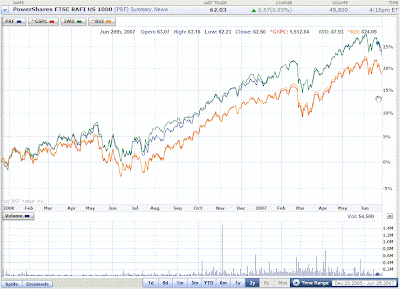Six months has passed since we last checked in on how well the concept of weighting the component stocks according to fundamental business metrics is working in practice.
Today, we'll compare the performance of the fundamental-weighted Powershares RAFI 1000 Exchange Traded Fund (Ticker: PRF) at this point against the S&P 500, the iShares Russell 1000 Value Index (Ticker: IWD), and the Russell 1000 (Ticker: RUI). The relative performance of all four funds are plotted over the term of PRF's existence below (click the image for a larger version):

At the 18 month mark, the fundamental-weighted PRF is performing considerably better than the S&P 500 and the Russell 1000. Meanwhile, it has largely kept pace with the Russell 1000 Value Index. The following chart reveals the annualized rates of return over the 18-month period beginning from the launch of the PRF exchange traded fund on December 20, 2005:

As of the close of trading on June 20, 2007, fundamental indexing has provided a slight-to-good advantage over the other established indices.
Other Fundamental-Weighted Index News
Back in April, Charles Schwab announced that it would offer three new open-end mutual funds in the U.S. based upon the fundamental-weighted indexing concept developed by Rob Arnott, with Schwab calling it a "better mousetrap."
That "better mousetrap" is being disputed by some of the investing world's heaviest hitters, and is now being examined more closely. (Follow the links for more details!)
And for a quick who's who of who's involved in the debate (aside from Charles Schwab, Rob Arnott and, well, us....), on the institutional side, a number of firms such as Vanguard and Barclays have offered criticism, index fund pioneer Jack Bogle, and a number of academics have also weighed in, or will be soon, including Princeton's Burton Malkiel, Harvard's Andre Perold, Wharton's Jeremy Siegel, and Nobel prize winner Henry Markowitz (of modern portfolio theory fame.)
Previously on Political Calculations
- Fundamental Indexing: Market Wrap for Year 1
When PRF turned one year old, we marked the occassion by comparing against the market capitalization-weighted funds that would seem to be the most similar.
- Are Fundamental ETFs Worth Their Premium?
The fees being charged by brokerage houses are higher than those of regular index funds. Here, we examined whether the improved returns are justifying the higher expenses for investors. (The answer as of this writing still appears to be "Yes.")
- Where Are the Fundamental ETFs?
We first checked in on the performance of the PRF fundamental-weighted ETF against the major stock indices at the ETF's 6-month old mark.
- Indexing Fundamentals
We first explored the fundamental-weighted index fund concept in this post. Essential reading for the basic background!
Labels: investing
Welcome to the blogosphere's toolchest! Here, unlike other blogs dedicated to analyzing current events, we create easy-to-use, simple tools to do the math related to them so you can get in on the action too! If you would like to learn more about these tools, or if you would like to contribute ideas to develop for this blog, please e-mail us at:
ironman at politicalcalculations
Thanks in advance!
Closing values for previous trading day.
This site is primarily powered by:
CSS Validation
RSS Site Feed
JavaScript
The tools on this site are built using JavaScript. If you would like to learn more, one of the best free resources on the web is available at W3Schools.com.